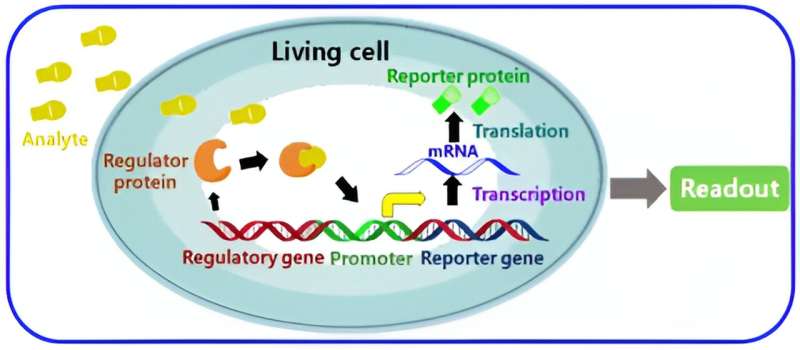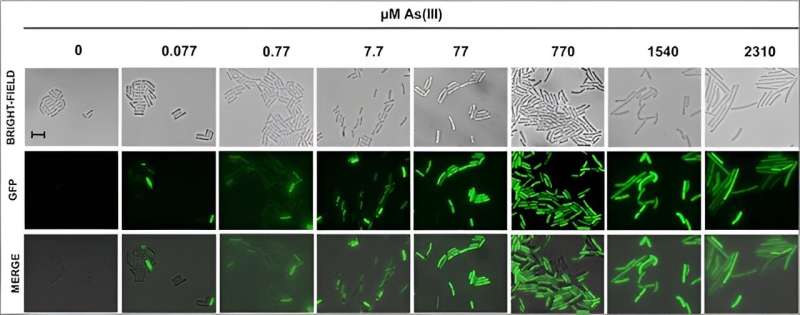This article has been reviewed according to Science X's editorial process and policies. Editors have highlighted the following attributes while ensuring the content's credibility:
fact-checked
trusted source
proofread
Bacterial biosensors: The future of analyte detection

Scientists can do some nifty things with microbes, including engineering bacterial cells to sense and signal the presence of specific compounds. These microbial whole-cell biosensors have numerous purposes, from detecting toxins in the environment to signaling infections or disease in humans. Propelled by advances in synthetic biology, researchers are continuing to refine the methodology for creating bacterial biosensors and are developing new ways to apply these devices to promote human and planetary health.
What are whole-cell biosensors?
To survive, bacteria need to know what is going on around them. "They have a lot of sensors that are naturally part of their physiology," said Caroline Ajo-Franklin, Ph.D., a professor of biosciences at Rice University whose synthetic biology lab develops microbial biosensors. "[However], these sensors don't just sense," she continued, "they [also] tell the bacteria to do something. What we're really trying to do in the field is leverage those natural responses to have the bacteria tell us, as humans, what they're seeing [and] what they're feeling."
Though there are countless ways to make a whole-cell microbial biosensor, the basic principle is the same: A bacterial cell is programmed (usually via genetic engineering) to recognize and generate a measurable signal in response to a molecule of interest. In the natural course of events, a compound binds a receptor on a bacterium, triggering a transcriptional cascade and production of proteins with specific physiological functions (e.g., efflux pumps). When generating biosensors, scientists "co-opt these responses [with a transducer] so that instead of having cells that just make [products like] efflux pumps, we engineer them to create a response we can read," Ajo-Franklin explained.
Depending on the biosensor and its intended use, this response can be electrochemical or involve expression of fluorescent or luminescent reporter proteins. Whole-cell biosensors are often engineered to work only when their target molecule is present. This ability to fine-tune specificity and sensitivity has made bacterial biosensors promising analytical tools.
How are bacterial biosensors used?
Perhaps a better question is: What can't bacterial biosensors be used for? The list of applications for these tiny tools is continuously growing. In general, however, their applications can be split into two categories: environmental and biomedical.
Environmental applications
On the environmental front, whole-cell biosensors provide insight on nutrient levels and organic compounds in soils, which can inform methods for managing crop growth. They can also signal the presence and levels of potentially problematic compounds. For example, Ajo-Franklin's group, along with collaborators at Rice, developed a biosensor that can detect thiosulfate, a chemical commonly used in water treatment that in excess amounts can trigger microbial freshwater blooms.
Notably, most biosensors rely on transcription of a reporter gene to produce a signal, which takes time (up to 30 minutes) and lots of cellular energy. In an effort to optimize the process, the Rice team took a post-translational approach, creating a synthetic electron transport chain in Escherichia coli. Electrons from thiosulfate move through this synthetic chain and ping up against an electrode, generating an electrical current in one minute or less. With this technology, "we have the chance to rapidly respond to an unintended release [of an environmental toxin] so that we could mitigate the ecological impact," Ajo-Franklin said.
Biomedical applications
In addition to nutrients and toxic compounds, bacterial biosensors can be designed to respond to, well, other bacteria. Microbes secrete all sorts of metabolites, many of which could serve as target analytes. For instance, microbial biosensors that detect quorum sensing molecules secreted by bacterial pathogens can signal the presence of disease-causing microbes in water, or in human samples to help diagnose infections.
Indeed, bacterial biosensors may provide useful intel into the health of human patients. A recent study described a biosensor made from the environmental bacterium, Acinetobacter baylyi, that can detect DNA from cancer cells in vitro and in a mouse model. This study provides a basis for the application of microbial biosensors in cancer detection and diagnosis.
Scientists have also created ingestible biosensors that can detect bleeding or inflammatory biomarkers in the gut to monitor intestinal health; the signals from these internal microbial devices can be transmitted to external devices, like cellphones, thus illustrating how biosensors can be paired with existing digital technologies to facilitate data collection and analysis.

There are already tools and technologies for tasks like monitoring analytes in soil or diagnosing disease. So, why use biosensors at all? Ajo-Franklin noted that, in most cases, standard instrumentation and tests are fine—there really isn't a need to use biosensors for, say, detecting pH or oxygen levels. But when it comes to chemical specificity, biosensors really shine.
"Where I think biology is super amazing is that it can tell the difference between, [for example], an estrogen agonist and an estrogen antagonist very rapidly," she said, alluding to her lab's use of their rapid biosensor to detect estrogen antagonists that can disrupt reproduction of marine vertebrates. Capitalizing on the natural specificity of microbial signaling allows scientists to find exactly what they are looking for in the molecularly messy natural world.
Bacterial biosensors can also be deployed in an environment without physically disrupting the local ecosystem (e.g., altering a landscape for soil sampling). An added benefit is that microbial biosensors are relatively inexpensive to prepare and store, thus making them potentially valuable in regions with low resources where traditional analytical instrumentation or testing may not be accessible—whether that's remote regions on Earth or even on other planets.
What's next?
With the way the field is progressing, a world where bacterial biosensors will become common analytical tools is not far off. As they advance toward that future, researchers are focusing on several key areas of development.
One of the most important conversations surrounding bacterial biosensors is how to safely use them—the microbial devices can't and shouldn't be released into the environment without constraints. Ajo-Franklin highlighted that implementing levels of control, such as developing tactics to contain the microbes both physically (e.g., confining them in a capsule or matrix of some kind) and biochemically (i.e., if they somehow escaped a physical restraint, they would no longer replicate or be metabolically active), will be key.
There are also efforts to engage with the public and policymakers to understand and address concerns surrounding the generation and deployment of microbial biosensors. "No one has a problem with canaries in a coal mine," Ajo-Franklin said. "[But] when it's a genetically engineered canary, it's a different story."
Ideally, bacterial biosensors of the future will do more than just sense, but also respond; that is, a sensor might not only detect the presence of a pollutant, but also degrade it. This is, after all, what bacteria do naturally—they sense a threat and deal with it. Ajo-Franklin likened the goal of coupling sensing with action to dealing with a fire in the lab—if you see a fire, you pull the fire alarm and get the fire extinguisher. You don't pull the fire alarm and stand there, twiddling your thumbs.
But what happens if, theoretically, every fire is different and requires a unique fire extinguisher? The chemical specificity of bacterial biosensors is great, but it's a bit unrealistic to make a brand new one for each of the thousands of compounds scientists might want to detect. There is thus a push toward developing biosensors that detect molecular function rather than individual chemicals (e.g., looking for potential endocrine disruptors in a sample rather than just, for instance, BPA, one of many such disruptors).
To summarize, there's a lot to be done. Moving forward in all these directions requires an interdisciplinary approach that leans on the expertise of everyone from electrical engineers to those working in public policy. "I feel like [this approach] is both one of the challenges for all of us [working in the field], and one of the joys," Ajo-Franklin shared. "I'm lost and confused and excited all at the same time."
Provided by American Society for Microbiology





















